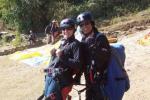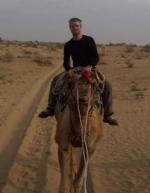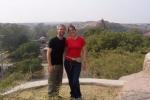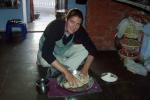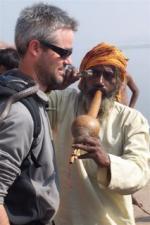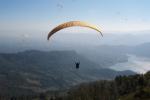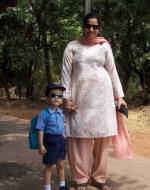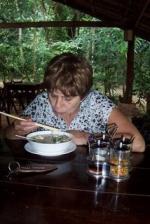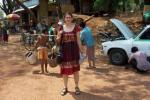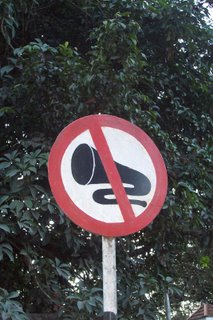
"Honking car horns is prohibited". Like most Nepali road signs, this one is entirely ignored.
All the Annapurna backpackers end up in Pokhara. Thus, it isn't long before we bump into a few of our trail friends and arrange a celebratory dinner- no daal bhaat allowed. After researching the most expensive restaurants in Pokhara, we come across a French bistro with an impressive wine list. You can always count on the Nepali for a solid effort at foreign cuisine, and while you could get a better "steak au poivre" in Normandy, what other French restaurant in the world has waiters serving you in North Fake jackets and hiking boots ?
Pokhara use to be a major destination on the Himalayan hippy pilgrimage in search of a free-love, free-pot, Shangri-la, but it now caters primarily to fat German tourists. Still, we had a lot of fun here and enjoyed some pretty tasty food before finally deciding to move on.
Inspired by the Korean Himalaya Woman, Andrew, Kimchi held convincingly between his metal chopsticks, enjoys a Korean pork barbecue in Pokhara with Katlijn. Koreans are avid hikers and some very authentic and tasty Korean restaurants have opened in Pokhara to cater to this demographic. In fact, we both decided that this was the best Korean food we had tasted since visiting Seoul a few years ago.
With a bit more time on our hands, we did some research on the bus situation in Nepal. It turns out they have something called "Tourist buses" which, for about 50 rupees extra (about 50 cents), provide you with marginally more comfort and safety. We take one to a small turnoff in the middle of nowhere and ride on the roof of a connecting bus going up to the small medieval town of Bandipur. The trip up to Bandipur is perfect for a little roof-riding as we climb above the clouds and are offered fantastic views of the Himalaya in the distance. Bandipur itself is a picturesque Newari town full of friendly people and some nice day hikes. We enjoy one relaxing day exploring the surrounding hills before continuing on to Chitwan.
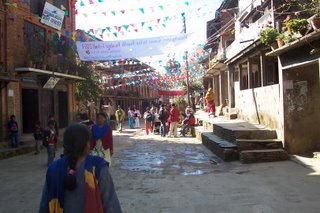
Main street Bandipur, a perfectly preserved Newari village.
There is no way to catch a tourist bus from Bandipur to Chitwan so we are crammed into a small jeep so full of people that arms and legs spill out of the windows- there is simply no place left to put all those limbs. We can hear the creaking and groaning of the rooftop buckling under the weight of so many passengers sitting above us. We take this for a half hour before being herded onto a public bus by a skillful tout, and pushed towards two seats at the very back with malfunctioning seat backs which, to the general amusement of the bus staff, force us to stare blankly at the ceiling for several hours before finally arriving at the city of Sauraha near Chitwan National Park.
Chitwan is a long way from the cold Himalaya mountains. It is located in the Central Terai region of Nepal. The park together with the neighbouring reserves and conservation areas encompasses almost 1500 square kilometers- mainly sal forests and grasslands. It is host to 450 species of birds and 50 different species of mammals. It is also one of the only safari parks of this type where you are actually allowed to walk through the park, though you must at all times be accompanied by knowledgeable guides for safety. We decide this is the best way to see Chitwan, despite some small risk of wildlife attacks.
We get up early in the morning and enjoy a peaceful paddle down the Rapti River in the mist. Along the way, we see marsh mugger crocodiles, and a bizarre looking creature called a "gardial" which is a kind of prehistoric crocodile with jagged teeth and a long snout- they have not evolved at all in the last 150 million years. We also get a very close look at a one-horned rhino above the river bank.

View of the misty moody Rapti River from our dugout canoe as we hunt for crocodiles.
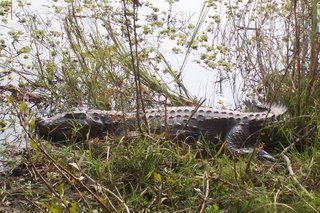
A marsh mugger sunning itself in the late morning. We owe the term "mugger" to British soldiers who watched these creatures emerge camouflaged from the reeds and drag local villagers to their watery death.
Before entering the sal forest, we are given instructions on what to do in the event of an attack by the various animals living in the park, except a Bengal Tiger. When I asked about this, he suggested the chances are pretty low, but I imagine there isn't much we can do about it anyhow. According to our guide, tigers hunt mostly at night and are not very active during the day. However, there are some incidents every year due to tigresses protecting their cubs or older tigers which discover that humans are relatively easy prey. A reassuring thought, for sure !
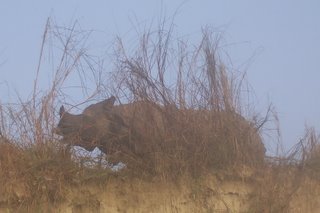
An endangered one-horned rhino. If you are ever charged by a rhino, the correct reaction is to run in a zig-zag pattern and drop articles of clothing behind you. This is often enough to throw off rhinos which have notoriously poor eye-sight and rely mostly on smell. If you are lucky, you will survive, intact, with your underpants still on.
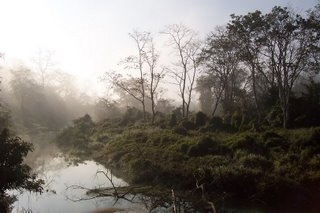
Entering the Sal forest.
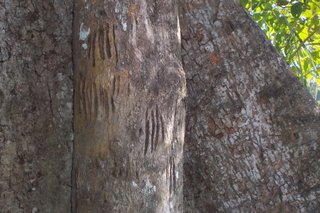
Claw marks of a Bengal Tiger. These markings together with its pungent urine demarcate its territory.
Our first morning is our most successful. It feels like walking through a fence-less zoo. We encounter spotted deer, barking deer, sambha deer, wild boars, rhinos, langur monkeys, red-face macaques, several gardials, and countless exotic birds. Katlijn and I march between our two guides who are armed with small staffs.
A Bengal Tiger sighting is the ultimate prize of any Chitwan safari and both Katlijn and I want to see this more than anything, until we hear a cat-like growl emerging unseen between the Sal trees and watch our guides turn pale. They motion us to stay still and position themselves in front, fingering their staffs. It occurs to me that our guides are shorter than me and a shade too spindly to take on a tiger with a couple of bamboo sticks. As they eye each other apprehensively, I can see them thinking the same thing. We slowly move away from the forest and further up the path where we are told to crouch down and wait. "It's a tiger !" one our guides whispers. We wait a long time, not quite certain anymore that we actually want to see a tiger, but nothing emerges from the forest.
Afterwards, our guides agreed they heard two sounds: a rhino and a tiger. I only heard a tiger. In fact, a bit shaken from this experience, I pretty much only hear tigers in the forest for the rest of the day. Nevertheless, the afternoon is relatively uneventful. A wildlife safari is actually a more relaxing experience than I had imagined- it tends to involve a lot of waiting around in a wooden safety tower hoping for something to happen while, in fact, nothing does. After several rounds of "hammer, paper, scissor" I fall asleep for a few hours before our guides wake us up and tell us our safari was over for the day.
As it turns out, we had inadvertently timed our safari for the one day in the year that the villagers are allowed to go out to the grasslands and pick grass for use in their houses. They were singing loudly and deliberately make a lot of noise to avoid wildlife encounters, in direct contrast to what were were trying to do. Consequently, we met a lot of villagers, but hardly any wildlife in the afternoon.
Chitwan National Park was originally a plot of land used for royal hunting expeditions. Since it was reserved only for this purpose, it was spared the worst of habitat poaching and most of its animal species survived. However, the People's War resulted in deteriorated security in the area and both animal and habitat poaching resumed over the last ten years. The rhino population was reduced significantly and only a handful of tigers remain today. With improving security, police stations can now be seen throughout the park patrolling the area. If the political situation continues to improve, the park will be saved.
The nearby villagers have grown accustom to gathering wood from the forest which is of a superior quality to the wood they are allowed to use in their conservation area. In fact, it appears they are using the grass gathering day to smuggle it out. In most cases, the locals bundle the grass on their back and herd it to their village. There are so many of them doing this that, from the observation tower, it looks like the meadows are alive and the grass itself has decided to move into town. Our guide uses his staff to poke at one of the grass bundles revealing that many of them are decoys used to hide blocks of wood inside. It is such as simple ruse that the police are probably more or less aware of this and allow it to go on to some extant.
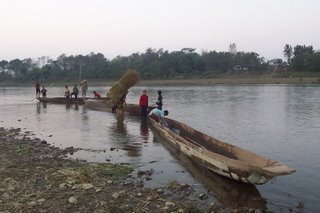
Villagers loading a dugout canoe with grass bundles. Interestingly, the original people living in the Chitwan area evolved a natural resistance to malaria.
We stay at a a gorgeous village in the middle of the jungle hosted by a friendly young Nepali woman. We decide to order the barbecue chicken, not having ever seen that on a Nepali menu before. This turns out to be an enormous evening-filling production involving catching a chicken, killing it, making a fire, and roasting it cave-man style. Sometime in the middle of the night, we finally get to eat our chicken. The overall gastronomic experience is always one part taste and one part atmosphere. This chicken was among the best we had ever tasted and even the best restaurant in the world could never fully realize the experience of eating it around an open fire with the Chitwan locals celebrating a successful day of gathering and smuggling.
Unfortunately, this inspiring dinner will forever be tainted in my mind by the fact that I spent much of the next day throwing it up all over the forest floor. At one point, I found myself retching next to the bloody chicken feathers- perhaps its ghost exacting revenge on me from its poultry after-life. Katlijn, however, was unaffected and enjoyed a full day safari while I recovered.
By the following morning, I was well enough again to walk back to Sauraha. We went briskly through the forest, barely stopping to watch the wildlife, so we could get to the Rapti River in time to help bathe the elephants.
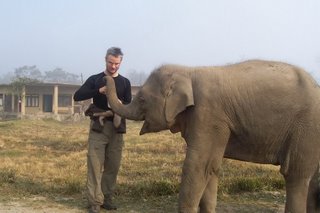
On the way back to Sauraha, Andrew stops at the elephant breeding center to feed a baby elephant the last of his digestive cookies.
Giving an elephant a bath is sure to capture the youthful soul in anybody. As we desperately try to climb up on the elephant's back, the trainer shouts commands causing the elephant to try to shake us off. It rolls around, shakes about, and sprays us with its nose. Meanwhile, children again, lost in the fun, we all forget how old we are and splash about together with the giant beasts.
I think one can safely say that it is a lot more fun to have a bath with an elephant than to actually ride on one. We decide we need to try an elephant safari that evening just to see what it is all about it. It turns out that an elephant safari involves being squeezed into a small box full of fat German tourists, and rocked about uncomfortably as the elephant waddles slowly through the forest. On the bright side, it is amazing how close you can get to the wildlife on an elephant. Deer are perfectly comfortable with elephants around, even when they are loaded with obnoxious tourists squeezing their camera triggers. Even the rhinos seem to barely notice us, sitting around lazily barely noticing us hovering over them.
|



